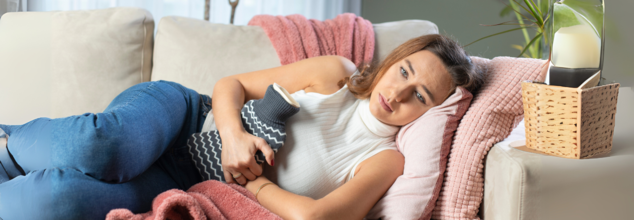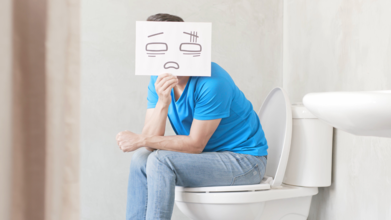- Health Conditions A-Z
- Health & Wellness
- Nutrition
- Fitness
- Health News
- Ayurveda
- Videos
- Medicine A-Z
- Parenting
- Web Stories
Depression During Periods: All About PMDD

Depression During Periods: All About PMDD
Each month, the storm would return—a wave of sadness and irritability, leaving me questioning myself. When I learned about PMDD, it was a relief to name the struggle. Through therapy, mindfulness, and small lifestyle changes I could possibly help my body recover but many women are unaware of this suffering and just assume it as part of a regular menstrual cycle.
Periods often come with a host of uncomfortable symptoms, including cramps, fatigue, and headaches. Yet, for many, the emotional toll can be even more challenging. Depression during periods, particularly tied to Premenstrual Dysphoric Disorder (PMDD), can significantly impact day-to-day life.
While periods can bring discomfort, understanding the link between hormones, mood, and PMDD can empower you to take charge of your health. By seeking appropriate treatment and making healthy lifestyle changes, you can manage PMDD effectively and regain control over your emotional and physical well-being.
Link Between Hormones and Mood
Hormonal fluctuations are a natural part of the menstrual cycle, but they also play a critical role in mood regulation. Changes in estrogen, progesterone, dopamine, and serotonin levels can trigger mood shifts and symptoms of depression.
Pre-Ovulation: Dopamine and estrogen levels rise, often enhancing mood and cognitive abilities.
Post-Ovulation: A drop in these hormones, especially estrogen and serotonin, can lead to irritability, sadness, and even depressive episodes.
During Periods: Hormonal levels begin to stabilize, which may alleviate mood symptoms in some people, but not all.
While not everyone experiences depression during their cycle, those with heightened sensitivity to hormonal changes or genetic predispositions may be more prone to severe mood symptoms.
What Is Premenstrual Dysphoric Disorder (PMDD)?
PMDD is a severe form of premenstrual syndrome (PMS) that affects approximately 5% of women of childbearing age. It goes beyond typical PMS symptoms, causing debilitating emotional and physical challenges. PMDD can disrupt daily life, relationships, and overall well-being.
Symptoms of PMDD
PMDD symptoms typically occur a week or two before menstruation and resolve within a few days of the period starting. Common symptoms include:
- Persistent irritability or anger
- Feelings of sadness, despair, or thoughts of self-harm
- Anxiety or tension, often accompanied by panic attacks
- Mood swings and frequent crying spells
- Loss of interest in daily activities and relationships
- Difficulty concentrating or making decisions
- Fatigue or low energy levels
- Food cravings or episodes of binge eating
- Trouble sleeping, including insomnia or hypersomnia
- Physical symptoms like cramps, bloating, breast tenderness, headaches, and muscle pain
What Causes PMDD?
While the exact cause of PMDD remains unclear, hormonal fluctuations are believed to play a pivotal role. Serotonin, a brain chemical that regulates mood, appetite, and sleep, undergoes changes throughout the menstrual cycle. Women with PMDD may have heightened sensitivity to these changes, bad mood and physical symptoms.
Diagnosing PMDD
PMDD diagnosis involves tracking symptoms over several menstrual cycles to identify patterns. A healthcare provider will typically review your medical history and conduct a physical examination. To meet the diagnostic criteria for PMDD, you must experience at least five symptoms, including one mood-related symptom, during the luteal phase of your cycle.
Treatment Options for PMDD
Managing PMDD often requires a combination of medical treatments and lifestyle adjustments. Here are some effective strategies:
Medical Interventions
1. Antidepressants
Selective serotonin reuptake inhibitors (SSRIs), such as sertraline, fluoxetine, and paroxetine, are FDA-approved for PMDD. These medications help regulate serotonin levels in the brain, alleviating mood-related symptoms.
2. Birth Control Pills
Certain oral contraceptives containing drospirenone and ethinyl estradiol can stabilize hormonal fluctuations, reducing PMDD symptoms.
3. Pain Relievers
Over-the-counter medications like ibuprofen, naproxen, and aspirin can ease physical discomfort, including cramps, headaches, and backaches.
Lifestyle Modifications
Engage in relaxation techniques, such as yoga, meditation, or spending time on enjoyable activities, to reduce tension.
Focus on a balanced diet, minimizing salty and sugary foods, which can worsen bloating and mood swings.
Physical activity helps release endorphins, improving mood and energy levels.
When to Seek Help
If PMDD symptoms significantly interfere with your life or you experience thoughts of self-harm, seeking medical help is crucial. Consult a healthcare professional to discuss treatment options tailored to your needs.
For immediate support in crisis situations, contact emergency services or a helpline like 911.
American Psychiatric Association. (2013). Diagnostic and statistical manual of mental disorders (5th ed.). Washington, DC: The American Psychiatric Association.
Harvard Psychologist Lists Careers Linked To Higher Rates Of Suicide: Doctors Maybe At High Risk Themselves

(Credit- Canva)
Suicides are one of the leading causes of death around the world. While it is easy to say that the person who chose to take their lives did it of their own violation, Harvard psychologist Dr. Matthew Nock, explains the other side. “90% of people who try and kill themselves say, I didn't want to die per se. I wanted to escape from seemingly intolerable.” Speaking on the On Purpose podcast with Jay Shetty, Dr. Nock pointed out that the link between work pressure and suicidal thoughts varies by race and ethnicity.
The concerning rise in suicide cases tied to work pressure has fueled a social media conversation about toxic work culture. What was once considered a normal part of the professional grind is now being openly challenged, as people share personal stories of the anxiety, depression, and isolation caused by unhealthy work environments.
What Professions Are At High Risk Of Suicide?
According to Dr. Matthew Nock, certain careers are linked to a higher risk of suicide.
Police Officers
He noted that physicians and police officers are among those at high risk. He mentioned a spike in suicides among New York City police officers, who are predominantly white men, and shared that female police officers, in particular, face a higher risk, even when accounting for factors like age, race, and ethnicity.
According to a 2025 study published in the Police Practice and Research, on average, 21.4 out of every 100,000 officers died by suicide each year.
The study showed that the suicide rate was much higher for male officers (22.7 per 100,000) than for female officers (12.7 per 100,000).
Physicians
Dr. Nock explained that access to means is a significant factor in these high-risk professions, which helps explain why physicians, police officers, and military members have a much higher risk of suicide compared to others.
Another study published in 2024 The BMJ, showed that the number of suicides among doctors has been going down, female doctors are still at a much higher risk than other people.
When looking at all the data, male doctors were found to have a 5% higher risk of suicide compared to the general population.
In a more recent analysis of the last few years, the overall suicide rate for doctors has decreased, which is good news. But even with this improvement, female doctors still have a 24% higher risk than the general public.
Why We Need To Talk More About Suicide
Dr. Nock stresses the importance of openly discussing suicide, particularly in schools. He compared it to fire drills or earthquake preparedness, saying that since 15% of people will experience suicidal thoughts, it's crucial to equip everyone with a safety plan..Dr. Matthew Nock said, "We know that asking about suicide, talking about suicide, does not make people suicidal."
He noted that the people who act on suicidal thoughts often show different signs than those who just have the thoughts. While depression is a strong predictor of having suicidal thoughts, other factors like anxiety, aggressiveness, poor behavioral control, and drug or alcohol use are more closely linked to a person actually attempting suicide.
He believes that a small educational module on suicide in health class could help save lives by teaching people what to do if they or someone they know is struggling.
Lung Cancer Rates Linked With Pollution Are Down In US, But THIS Country Is Still Suffering: Study

(Credit- Canva)
While we all know air pollution affects our health, did you know that it was actually driving cancer cases higher? This has led to a big rise in health problems worldwide. Past studies show that air pollution is linked to about seven million premature deaths each year and contributes to over 3% of all years of healthy life lost globally. This revelation was a big concern for public health, and to fix it, many measures were taken.
While some countries like the US showed promising results in bettering public health, a recent study in the International Journal of Public Health showed that this positive trend is not yet showed up in China.
How Is PM2 Pollution Affecting Our Health?
One of the most dangerous types of air pollution is called fine particulate matter, or PM2.5. These tiny particles come from car exhaust, factory smoke, and even from the smoke created by burning solid fuels inside homes. Because they are so incredibly small, they can stay suspended in the air for a long time and, when we breathe them in, they go deep into our lungs.
Once inside the body, PM2.5 can cause inflammation and even change our genes, which increases our risk for many illnesses, especially tracheal, bronchial, and lung (TBL) cancers. A new study looked at how much PM2.5 pollution has affected TBL cancer rates in China, Japan, South Korea, and the United States from 1990 to 2021.
Has Pollution-Related Health Risk Decreased Everywhere?
The study, which used data from the Global Burden of Disease (GBD) project, found some important trends:
Overall Cancer Rates Are Declining
The good news is that globally, the number of deaths and years of healthy life lost due to TBL cancer linked to PM2.5 pollution are going down. This positive trend was consistent in all the countries studied: China, Japan, South Korea, and the U.S.
China's Unique Challenge
Despite this global trend, China faced a much higher death rate from TBL cancer linked to PM2.5 compared to the other three countries. While their rates are decreasing, they still remain significantly higher than the worldwide average.
Household Pollution Hits Women Harder
The research also looked at pollution from burning solid fuels inside homes. The global death rate from TBL cancer linked to this type of pollution has remained stable, but it's actually increasing for women while it's decreasing for men. This highlights a specific danger for women in homes that rely on these fuels.
Will This Pollution Cancer Trend Keep Rising?
Looking ahead, researchers predict that the global death rate for TBL cancer caused by PM2.5 will actually increase over the next 29 years. However, the study notes that countries like China, South Korea, and the U.S. are expected to see a significant drop in their rates, while Japan's numbers are expected to stay about the same.
Overall, this study shows that while air pollution is a serious global health risk, the efforts to reduce PM2.5 exposure in many countries are making a real, positive difference.
'You’ve Been Pooping Wrong All Your Life' According To Harvard Gut Doctor, 3 Mistakes That Harm Your Health

(Credit- Canva)
Maintaining our gut health is not as easy as it seems. Even things like how you do your bowel movements could reveal how healthy your gut actually is. According to Dr. Saurabh Sethi, a board-certified gastroenterologist, many of us are making common mistakes on the toilet that can lead to real health problems. Here are three crucial habits to change to improve your gut health. Here are three mistakes' people make will they are in the washroom.
3 Bathroom Mistakes You Are Making
Stop Straining
Pushing or straining when you poop can cause serious issues like hemorrhoids, which are swollen veins in your rectum and anus, and anal fissures, which are small tears in the lining of your anus. In more severe cases, it can even lead to rectal prolapse, where part of the rectum slides out of the anus. Instead of forcing it, focus on taking deep breaths. This helps your abdominal muscles relax and allows your body to do its job naturally, reducing the risk of painful complications.
Put Down Your Phone
Scrolling on your phone while on the toilet can be a bad habit. Spending extra time on the toilet, even if you’re not straining, puts pressure on the delicate veins in your rectum. This can cause them to swell, significantly increasing your risk of hemorrhoids. To protect yourself, it’s best to keep your bathroom breaks short—ideally, under five minutes.
Don't Ignore the Urge
When you feel the need to poop, it's important not to hold it in, which makes it much more difficult to pass later, leading to and worsening constipation. When you feel the need to go, listen to your body. Holding it in causes your stool to get harder and drier, which makes constipation much worse and more painful later on. Train your gut to go when it says it's time.
Simple Ways To Improve Your Bowel Movements
Go at the Same Time Each Day
Try to create a routine. If you're often straining without success, try sitting on the toilet about 30-60 minutes after a meal, when your colon is naturally more active. A little stretching or a short walk beforehand can also help things get moving.
Use a Stool for Your Feet
The natural position for a bowel movement is squatting. You can mimic this position on a regular toilet by placing a small stool under your feet to raise your knees above your hips. This simple change helps your muscles relax and can make bowel movements easier and more complete.
Focus on Fiber and Fluids
Fiber is essential for creating soft stool that's easy to pass. Most adults should aim for 25 to 35 grams a day. Just remember to add it to your diet slowly. As you increase your fiber, be sure to drink more water and other non-caffeinated fluids, since caffeine can dehydrate you and make stool harder.
When to Seek Help
While these tips are a great starting point, sometimes you need more personalized help. You should talk to your doctor if you notice any of these signs:
- A recent, unexplained change in your bowel habits
- Blood in your stool
- Unexplained stomach pain
- A pelvic health physical therapist can also provide a full evaluation and create a personalized plan to improve your bowel health.
© 2024 Bennett, Coleman & Company Limited

